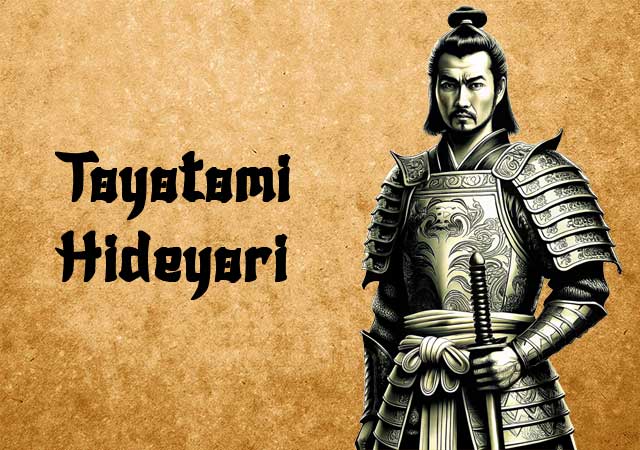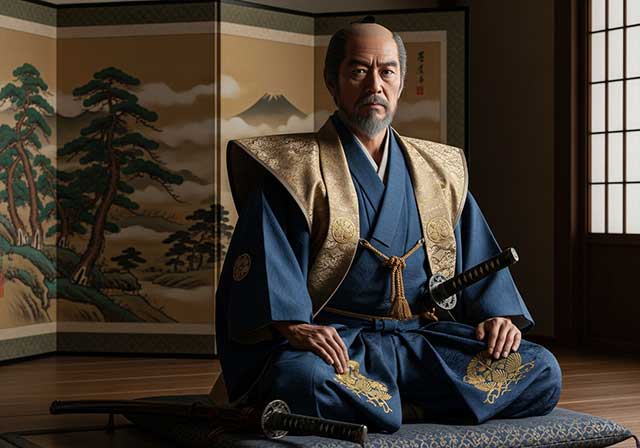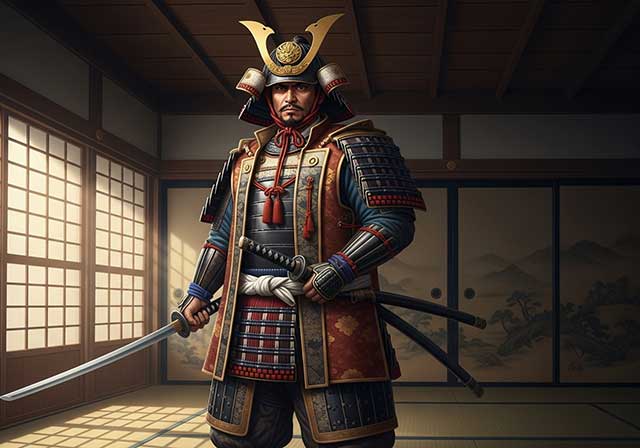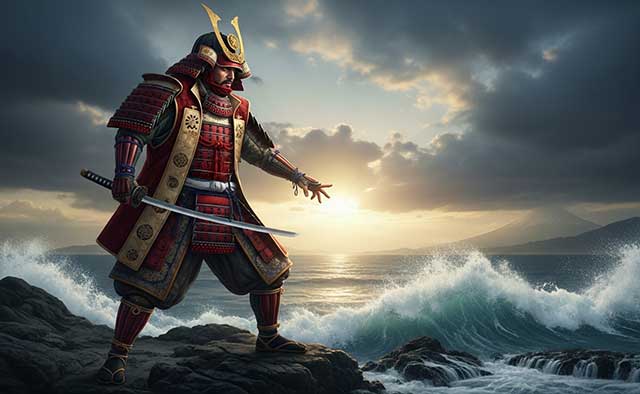
Toyotomi Hideyori (August 28, 1593 – June 4, 1615) was the son and designated successor of Toyotomi Hideyoshi, the general who first unified Japan. His mother, Yodo-dono, was Oda Nobunaga's niece.
Early Life and Political Struggles
Born in 1593, Hideyori was Hideyoshi's second son. His birth created a potential succession crisis, leading Hideyoshi to exile and later order the forced suicide of his nephew and heir, Toyotomi Hidetsugu, in 1595. Hidetsugu’s entire family, including women and children, were executed, solidifying Hideyori’s position as Hideyoshi’s successor.
Following Hideyoshi’s death in 1598, Japan was ruled by a council of five regents intended to govern until Hideyori came of age. However, Tokugawa Ieyasu quickly maneuvered to seize power, culminating in his victory at the Battle of Sekigahara in 1600. To neutralize Toyotomi influence, Ieyasu arranged Hideyori’s marriage to his granddaughter, Senhime, hoping to solidify political ties.
Conflict with Tokugawa
By 1614, Hideyori, now a young daimyō ruling from Osaka Castle, was seen as a growing threat by Ieyasu. Many samurai opposed to Tokugawa rule gathered around Hideyori, claiming he was Japan’s rightful leader. Tensions escalated when Hideyori held a dedication ceremony for the Great Buddha of Kyoto, which Tokugawa authorities interpreted as a prayer for their downfall. Ieyasu demanded Hideyori vacate Osaka Castle, but his supporters refused, prompting the Siege of Osaka (1614–1615).
The Siege of Osaka
The first phase, the Winter Campaign (1614), saw Tokugawa forces fail to breach the castle. A truce was reached, but the Tokugawa shogunate forced Hideyori to dismantle Osaka Castle’s defenses. In April 1615, Ieyasu learned Hideyori was amassing troops and preparing for war. The truce was broken, leading to the Summer Campaign (1615).
In the final battle on June 4–5, 1615, Hideyori’s forces initially performed well, using surprise tactics under Sanada Yukimura. The Tokugawa forces suffered heavy losses, and Ieyasu himself allegedly considered suicide when defeat seemed imminent. However, due to a miscommunication—caused by a letter from Ieyasu warning of a supposed conspiracy inside the castle—Hideyori delayed his attack, allowing the Tokugawa to regroup. Overwhelmed by superior numbers, Osaka Castle fell.
As Tokugawa troops stormed the castle, Hideyori and his mother, Yodo-dono, took refuge in a fireproof keep. Senhime attempted to negotiate for her husband's life, but Ieyasu refused, ordering his commanders to finish the attack. Under relentless artillery fire, Hideyori and his mother committed seppuku, marking the end of the Toyotomi lineage as a political force.
Aftermath and Legacy
Toyotomi Kunimatsu (Hideyori’s 8-year-old son) was captured and executed.
Naahime (Hideyori’s 7-year-old daughter) was sent to Tōkei-ji, a convent in Kamakura, where she later became its 20th abbess, Tenshūin (1608–1645).
Rumors persisted that Hideyori had escaped Osaka, causing concern for the Tokugawa shogunate. Reports from foreign sources, such as Richard Cocks and Jesuit missionaries, document that some believed Hideyori had fled to Satsuma or even overseas.
With Hideyori’s death, the last major resistance to Tokugawa rule ended, securing Tokugawa dominance for over 250 years.
See also
-
Otomo Sorin

Ōtomo Yoshishige came from a noble lineage, being the eldest son of Ōtomo Yoshiaki, the ruler of Funai Province. The roots of the Ōtomo family traced back to Fujiwara Hidesato, the adopted son of Nakahara Chikayoshi. Fujiwara served Minamoto Yoritomo during the Genpei War and took part in battles in Mutsu Province in 1189. In 1193, he was appointed shugo of Buzen and Bungo Provinces, after which he adopted a new surname—Ōtomo.
-
Okudaira Sadamasa

Sadamasa was the son of Okudaira Sadayoshi and took part in several battles under Tokugawa Ieyasu, distinguishing himself in the Battle of Anegawa in 1570, where he took two heads. Around 1572 he was forced to enter the service of the Takeda clan, but after the death of Takeda Shingen in 1573 he returned to Tokugawa, leaving Tsukude Castle together with his men. As a result of this defection, Takeda Katsuyori ordered the execution of Sadamasa’s wife and brother, who were being held as hostages.
-
Okubo Tadatika

Tadatika, the son of Okubo Tadayō, entered the service of Tokugawa Ieyasu at the age of eleven, and took his first head in battle when he was sixteen. After the establishment of the Tokugawa shogunate, he was appointed as a rōjū — a senior bakufu official — and was regarded as one of Ieyasu’s most trusted advisors, alongside Honda Masanobu. He is also known for his military chronicle Mikawa Monogatari, which describes Ieyasu’s rise to power and the early years of the Tokugawa shogunate.
-
Okubo Nagayasu

Nagayasu was the second son of Okura Nobuyasu, a sarugaku theater actor from the Takeda clan. Takeda Shingen recognized the young man’s potential and took him into service, appointing him as a vassal to his general, Tsuchiya Masatsugu. During this period, Nagayasu changed his family name to Tsuchiya. He was entrusted with developing the Takeda clan’s gold mines as well as handling matters related to taxation.
-
Nitta Yoshisada

Nitta Yoshisada was a loyal soldier of Emperor Go-Daigo, who in the 1330s attempted to restore direct imperial rule in Japan. The Nitta family was related to the Ashikaga house and was older in lineage. However, they did not join Minamoto Yoritomo at the start of his war with the Taira, as the Ashikaga did, and therefore did not receive high positions in the Kamakura shogunate. This may have been one of the reasons why Yoshisada rose against the Hōjō clan in 1333.
-
Natsume Yoshinobu

Yoshinobu, a long-time vassal of the Matsudaira and Tokugawa clans, governed Hamamatsu Castle on behalf of the Tokugawa house. During the clashes between the Imagawa, Takeda, and Matsudaira clans, he served in the garrison of Nagasawa Castle and in 1562 took part in raids under the command of Itakura Shigezane. When, in 1563, a revolt of the Sōtō-shū sect followers broke out in Mikawa Province, Yoshinobu joined the rebels together with Honda Masanobu and Hachiya Sadatsugu.
-
Nambu Nobunao

The Nambu clan was an ancient and powerful family that traced its lineage back to the Minamoto shoguns and had controlled a significant part of the Tohoku region in northern Honshu since the 12th century. Nobunao was born in Ikatai Castle, located in what is now the city of Iwate. He was the second son of Ishikawa (Nambu) Takanobu, the 22nd head of the Nambu clan. In 1565, Nobunao’s uncle, Nambu Harumasa, adopted him, brought him to Sannohe Castle, and named him his heir, later giving his daughter in marriage to him.
-
Naito Ienaga

Ienaga was the son of Naitō Kiyonaga and served Tokugawa Ieyasu from an early age. Like his father, he was exceptionally brave, and thanks to his remarkable skill with the bow, he earned the nickname “the unrivaled archer.” Although both the elder and the younger Naitō belonged to the Jōdo Shinshū (“True Pure Land”) sect, during the Ikkō-ikki uprising in Mikawa Province in 1565, Ienaga did not support his fellow believers and instead sided with Tokugawa Ieyasu, earning his special trust. He later took part in the battles of Mikatagahara, Nagashino, and many other engagements while accompanying Ieyasu.

